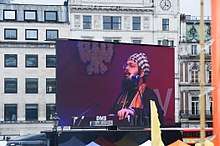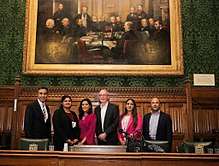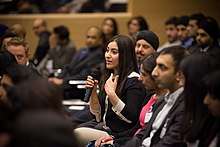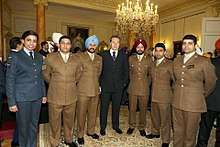Sikhism in the United Kingdom
| Part of a series on |
| Sikhism |
|---|
 |
|
|
General topics
|
|
|
Sikhism was recorded as the religion of 420,196 people resident in England at the 2011 Census, along with 2,962 people in Wales,[1] 9,055 in Scotland[2] and 216 in Northern Ireland,[3] making for a total Sikh population of 432,429.[4]
| Historical Population | ||
|---|---|---|
| Year | Pop. | ±% |
| 1961 | 16,000 | — |
| 1971 | 72,000 | +350.0% |
| 1981 | 144,000 | +100.0% |
| 1991 | 206,000 | +43.1% |
| 2001 | 340,810 | +65.4% |
| 2011 | 432,429 | +26.9% |
| Religious Affiliation was not recorded prior to 2001. | ||
History

Sikhs and Britain have a long and storied history. Decades before the last Sikh King, Duleep Singh, stepped onto British soil in the middle of the 19th century, there had been Anglo-Sikh contact as far back as the 1800s in the Punjab with his father Maharaja Ranjit Singh. Since then, even though this relationship has changed in nature many times, both communities have left a permanent mark on each other. For instance, in such varied parts of British society as food, language, political systems, soldiering and of course cricket, the British-Sikh relationship has given rise to many new facets of modern British and Indian society.[5]
The first Sikh settler in Britain was Maharaja Duleep Singh (1838-1893), the last Sikh Emperor of the Imperial Sukerchakia Dynasty, from 1844-1849. He arrived in England in the year 1854, having been exiled from his Kingdom by the British. His mother, Empress Jind Kaur (1817-1863), arrived in 1860 at Kensington in Victorian London and settled permanently, after fighting the British for a long time until the fall of the Sikh Dynasty in 1849. She was given permission by the British Parliament to settle on English soil. A jewel on the UK queen's crown belonged to, and was stolen from Maharaja Ranjeet Singh.
The First Sikh Settlers started migrating from the Punjab in 1911, when the first Sikh Gurdwara was opened in London. During the start of the First and Second World Wars respectively, there was already an established Sikh presence in many parts of England. In London itself the community was small but this grew very rapidly during the 1950s and 60s and faced much racism and discrimination, mainly owed to the appearance and skin colour.
Demographics
British Sikhs are considered one of the best example of cultural integration in the United Kingdom. A strong work ethic combined with an emphasis on the importance of the family has been the reason why Sikhs have been so successful.[6]
Education

65% of Sikhs have a graduate level qualification or above. Sikhs in the 20 - 34 age group have the highest level of graduates (55%) within the Sikh community. The highest level of post graduate Qualifications of Masters degrees (22%) is in the 35 - 49 age group. 8% of Sikhs aged 65 and over have a PHD. The split of formal education between women and men is roughly equal, with slightly more women holding a university degree or equivalent (48% of women, 42% of men).[7]
Employment

The most popular employment sectors for British Sikhs include: Healthcare (10%), IT and Technology (8%), Teaching and Education (9%), Accountancy and Financial Management (7%). This demonstrates that Sikhs tend to favour professional and technical employment sectors compared with others. Healthcare is a popular sector for all age groups. Teaching and Education is more popular with the 35 - 49 and the 50 - 64 age groups than other groups, whereas accountancy and financial management is more popular with the 20 - 34 age group (9%) compared with 6% respectively for both the 35 - 49 and the 50 - 64 age groups. The top career choices for Sikh women are Healthcare (14%) and Teaching and Education (15%). Healthcare is also a joint second most popular choice for Sikh men along with Accountancy and Financial Management, the most popular sector being IT and Technology (13%).[8]
Wealth
Home ownership
Home ownership is very high amongst British Sikhs with 87% of households owning at least a portion of their home. 30% of British Sikh households own their homes outright and only 9% rent their properties. A mere 1% of British Sikhs claim Housing Benefit. This represents the highest level of private home ownership rate over any other community in the UK. In addition half of all British Sikh families (49%) own more than one property in the UK, with a similar number (50%) owning at least one property in India. British Sikh families appear to use property as a means of building assets for the future. 6% of British Sikhs own property elsewhere in Europe.[9]
Income
According to the ONS, the national average income for British households is approximately £40,000 before tax. With these values in mind the British Sikh Report 2014 found that Sikh households tend to be affluent. Two in every three British Sikh households (66%) have pre-tax incomes in excess of £40,000, and over a third of British Sikh households (34%) have an income in excess of £80,000 giving a value for the Sikh Pound of 7.63 billion.[10]
Business
British Sikhs are clear net contributors to the British economy and have a strong entrepreneurial drive, with about one in three British Sikh families (34%) owning a business in the UK.[11]
Charitable giving and volunteering
_in_London.jpg)
Performing Seva (selfless service) is a basic tenet of Sikhism, and Sikhs are also expected to share at least 10 per cent their earnings with those less fortunate and for good causes (Dasvandh).
64 per cent of the British Sikhs engage in some volunteering work. 40 per cent give between one and five hours of their time per week on voluntary activities, including Seva at their Gurdwara, whilst more than two per cent spend over 25 hours on such activities. Sikhs spend about 200 hours per year on voluntary activities on average. 93 per cent of Sikhs also donate some money to charity every month, with only seven per cent not donating any. Over 50 percent of Sikhs donate between £1 and £20 every month, and 7 per cent donate more than £100 per month. It is estimated that Sikhs in Britain donate around £380 per year to charity on average. Taken as a whole, Sikhs in the UK are estimated to donate about £125 million to charity per annum and spend over 65 million hours each year on voluntary activities.[12]
Care of the elderly
There is a tradition that Asian families tend to live together in extended households, and the majority of Sikhs prefer to live with extended family as they grow older - 61% of males and 52% of females. The second highest preference is in their own home (44% males and 41% females) and the third preference is in a retirement village with 31% females and 24% males wanting to live in a retirement village.[13]
Festivals and community events

Some of the bigger festival celebrations within the British Sikh community include Vaisakhi which usually involves colourful street processions throughout the country and Diwali. Southall hosts one of the largest Vaisakhi street processions in Europe.[14] Since 2009, both Vaisakhi and Diwali have been celebrated every year at 10 Downing Street, the residence of the British Prime Minister.[15][16]
Exemptions in British law for Sikhs
Sikhs are exempt from a couple of British laws; for example they are permitted to ride motorcycles without a helmet (so long as they are wearing a turban) and are permitted to carry around their Kirpan in situations where it would otherwise be seen as an offensive weapon. In February 2010 Sir Mota Singh, Britain's first Asian judge, criticised the banning of the Kirpan in public places such as schools.[17]
British converts to Sikhism
- Russell Brand is not a Sikh but follows Kundalini Yoga as taught by the Sikh spiritual leader Yogi Bhajan which uses Sikh mantra[18]
- Alexandra Aitken - actress and daughter of former British cabinet minister Jonathan Aitken
- Vic Briggs - former blues musician, now Vikram Singh Khalsa; became the first non-subcontinental to perform kirtan at Harimandir Sahib
- Max Arthur Macauliffe (1841–1913) - senior administrator of the British Raj who was posted in the Punjab; prolific scholar and author; converted to Sikhism in the 1860s
Discrimination of Sikhs in the UK
74.5% of Sikhs have experienced racism in the United Kingdom. In spite of this 95% of Sikhs are proud of being born and living in the UK.[19]
The BBC have reported that around 71% of British Sikh women "have experienced gender discrimination" and "have done so within their extended family".
Influential British Sikh organisations
The Gurdwara remains the focal point of the Sikh community. There are also now a variety of additional organisations which have been setup by Sikhs to support the community:
- British Sikh Association
- British Sikh Report
- City Sikhs
- Gurdwara Sahib Leamington and Warwick
- Guru Nanak Nishkam Sevak Jatha
- Gurdwara Sri Guru Singh Sabha Southall
- Guru Nanak Gurdwara Smethwick
- Guru Nanak Darbar Gurdwara
- Khalsa Aid
- Network of Sikh Organisations
- Sangat TV
- Sikh Council
- Sikh Pioneers & Sikh Light Infantry Association UK
- Sikh Channel
- Sikh Federation (UK)
- The Sikh Awards
- UK Punjab Heritage Association
Controversies
Allegations of forced conversions of Sikh girls to Islam
In 2007 a Sikh girl's family claimed that she had been forcibly converted to Islam, and they received a police guard after being attacked by an armed gang.[20] In response to these news stories, an open letter to Sir Ian Blair, signed by ten academics, argued that claims that Hindu and Sikh girls were being forcefully converted were "part of an arsenal of myths propagated by right-wing Hindu supremacist organisations in India".[21] The Muslim Council of Britain issued a press release pointing out there was a lack of evidence of any forced conversions and suggested it was an underhand attempt to smear the British Muslim population.[22]
An academic paper by Katy Sian published in the journal South Asian Popular Culture in 2011 explored the question of how "forced conversion narratives" arose around the Sikh diaspora in the United Kingdom.[23] Sian, who reports that claims of conversion through courtship on campuses are widespread in the UK, says that rather than relying on actual evidence they primarily rest on the word of "a friend of a friend" or on personal anecdote. According to Sian, the narrative is similar to accusations of "white slavery" lodged against the Jewish community and foreigners to the UK and the US, with the former having ties to anti-semitism that mirror the Islamophobia betrayed by the modern narrative. Sian expanded on these views in 2013's Mistaken Identities, Forced Conversions, and Postcolonial Formations.[24]
BBC programme highlighting grooming of Sikh girls by Muslim men
A BBC Inside Out (London) programme televised in September 2013 interviewed several young Sikh women who were allegedly groomed and sexually abused by Muslim men, with one alleged ex-groomer even admitting that they specifically targeted Sikh girls. Bhai Mohan Singh, working for the Sikh Awareness Society (SAS), told the BBC he was investigating 19 cases where Sikh girls were allegedly being groomed by older Muslim men,[25] of which one ended with a successful conviction.[26][27] In August 2013 four Muslims and two Hindus were convicted at Leicester Crown Court of paying a "vulnerable and damaged" 16-year-old Sikh girl for sex:[28] the investigation which had led to their being arrested and charged had been opened due to evidence Bhai Mohan Singh had presented to the police.[27] However, a report published in the previous year by Faith Matters (which runs the TELL MAMA anti-Muslim violence helpline and works closely with the Jewish Community Security Trust[29]) claimed that the Sikh Awareness Society included radical anti-Muslim elements among its members;[30][31] Faith Matters furthermore alleged that it was a matter of "common consensus" that the radical Sikhs said to have had secret meetings with the English Defence League were members of the SAS.[30][31] The SAS deny the allegations and have distanced themselves from the organization,[30][31] a spokesperson telling Hope not Hate: "We would have nothing to do with any racist or fascist group, certainly one that uses religion to divide people…I know nothing about this and no, we are not in any kind of talks and discussion with them".[32] The Nihal Show on the BBC Asian Network discussed the issue and debated the merits of the grooming claims in September 2013.[33]
Behzti theatre performance
Behzti (Dishonour), a 2004 play by Gurpreet Kaur Bhatti, sparked such controversy that its performances were cancelled. A scene set in a gurdwara included scenes of rape, physical abuse and murder. Sikhs protested its opening night, 18 December 2004, at the Birmingham Repertory Theatre. Performances of the play at the Rep were cancelled two days later.
Inter-faith marriages between Sikhs and non-Sikhs
Holding an Anand Karaj wedding ceremony between a Sikh and a non-Sikh has become a contentious issue. In 2016, armed police arrested scores of protesters at Gurdwara Sahib in Leamington Spa, which The Telegraph claims "has a history of tensions over mixed marriages".[34] Sikh Youth UK, who were behind the protest, blamed "a rogue Gurdwara committee creating discord".[35] One Sikh journalist called the issue a "deepening schism"[36] while another deplored the protesters' use of masks, and the way their actions allowed the kirpan (ceremonial dagger) to be seen as a bladed weapon, thus giving "the racists and the bigots justifications for their ignorant hatred".[37] An investigation on BBC Asian Network found that these disruptions over interfaith marriage had been going on for years.[38]
See also
- List of British Sikhs
- Sikhism in England
- Sikhism in Northern Ireland
- Sikhism in Scotland
- Sikhism in Wales
- British Indians
- British Punjabis
- British Sikh Report
Further reading
- Sikhs in Britain: the making of a community (Zed, 2006) by Prof. Gurharpal Singh and Dr. Darshan Singh Tatla.
References
- ↑ "Table QS210EW 2011 Census: Religion (Detailed), local authorities in England and Wales". Office for National Statistics. 11 December 2012. Retrieved 8 April 2017.
- ↑ "Religion (detailed): All people" (PDF). National Records of Scotland. Retrieved 8 April 2017.
- ↑ "Religion - Full Detail: QS218NI". Northern Ireland Statistics and Research Agency. Retrieved 8 April 2017.
- ↑ "United Nations Table 9: Population by religion, sex and urban/rural residence". Office for National Statistics. 21 January 2015. Retrieved 8 April 2017.
- ↑ "British Sikh Report 2016 | British Sikh Report". www.britishsikhreport.org. Retrieved 2018-06-24.
- ↑ "Comment: British Sikhs are the best example of cultural integration". politics.co.uk. Retrieved 2018-06-24.
- ↑ "British Sikh Report 2018 | British Sikh Report". www.britishsikhreport.org. Retrieved 2018-06-24.
- ↑ "British Sikh Report 2018 | British Sikh Report". www.britishsikhreport.org. Retrieved 2018-06-24.
- ↑ "BSR 2014 | British Sikh Report". www.britishsikhreport.org. Retrieved 2018-06-24.
- ↑ "BSR 2014 | British Sikh Report". www.britishsikhreport.org. Retrieved 2018-06-24.
- ↑ "BSR 2014 | British Sikh Report". www.britishsikhreport.org. Retrieved 2018-06-24.
- ↑ "British Sikh Report 2016 | British Sikh Report". www.britishsikhreport.org. Retrieved 2018-06-24.
- ↑ "British Sikh Report 2018 | British Sikh Report". www.britishsikhreport.org. Retrieved 2018-06-24.
- ↑ Clifton, Katy (2018-04-09). "Thousands brave rain for Vaisakhi celebration in Southall". getwestlondon. Retrieved 2018-06-24.
- ↑ PTI (17 October 2009). "Brown celebrates Diwali at 10, Downing Street, in a 'historic' first". Times of India. Retrieved 3 November 2013.
- ↑ Roy, Amit (25 October 2011). "Dazzle at downing, colour at commons". Mumbai Miday. Retrieved 3 November 2013.
- ↑ Taneja, Poonam (8 February 2010). "Sikh judge Sir Mota Singh criticises banning of Kirpan". Retrieved 5 September 2013.
- ↑ banana (2015-06-10), Russell Brand Demo's Kundalini Yoga Meditation & Prayer, retrieved 2018-06-24
- ↑ Talwar, Divya. "British Sikh Report finds majority 'proud of Britain'". BBC News. Retrieved 5 September 2013.
- ↑ Cowan, Mark (Jun 6, 2007). "Police guard girl 'forced to become Muslim'". Birmingham Mail. Retrieved 19 August 2013.
- ↑ Hundal, Sunny (13 March 2007). "Where is the Hindu Forum's evidence?". Pickled Politics. Archived from the original on 29 October 2013. Retrieved 26 October 2013.
:Dear Ian Blair, :As academics teaching at British universities, we are disturbed by your recent announcement reported in the Daily Mail (22 February), Metro (23 February) and elsewhere, that the police and universities are working together to target extremist Muslims who force vulnerable teenage Hindu and Sikh girls to convert to Islam. Your statements appear to have been made on the basis of claims by the Hindu Forum of Britain who have not presented any evidence that such forced conversions are taking place. In fact the notion of forced conversions of young Hindu women to Islam is part of an arsenal of myths propagated by right-wing Hindu supremacist organisations in India and used to incite violence against minorities. For example, inflammatory leaflets referring to such conversions were in circulation before the massacres of the Muslim minority in Gujarat exactly five years ago which left approximately 2,000 dead and over 200,000 displaced :In our view, it is highly irresponsible to treat such allegations at face value or as representative of the views of Hindus in general. While we would condemn any type of pressure on young women to conform to religious beliefs or practices (whether of their own community or another) we can only see statements such as yours as contributing to the further stigmatising of the Muslim community as a whole and as a pretext for further assaults on civil liberties in Britain. - ↑ http://www.mcb.org.uk/media/presstext.php?ann_id=242
- ↑ Sian, Katy P. (6 July 2011). "'Forced' conversions in the British Sikh diaspora". South Asian Popular Culture. 9 (2): 115. doi:10.1080/14746681003798060.
- ↑ Katy P. Sian (4 April 2013). Unsettling Sikh and Muslim Conflict: Mistaken Identities, Forced Conversions, and Postcolonial Formations. Rowman & Littlefield. pp. 55–71. ISBN 978-0-7391-7874-4. Retrieved 15 June 2013.
- ↑ BBC Inside Out London, 02/09/2013: see from 06:00
- ↑ "Code of silence on sexual grooming?". http://bbc.co.uk. 2 Sep 2013. External link in
|publisher=(help) - 1 2 BBC Inside Out London, 02/09/2013: see from 24:10
- ↑ "Leicester child prostitution trial: Men admit paying girl, 16, for sex". BBC News. 1 August 2013. Retrieved 2 October 2013.
- ↑ Clegg, Nick. "Deputy Prime Minister extends funding to tackle hate crime against Muslims". Office of the Deputy Prime Minister. Retrieved 06 October 2013.
- 1 2 3 Lane, H.S.; Feldman, Matthew (September 2012). "A Study of the English Defence League" (PDF). Faith Matters: 29.
- 1 2 3 Elgot, Jessica (2012-09-24). "EDL Target Religious Groups Including Jews And Sikhs For Recruitment, Exploit Anti-Islam Tensions, Says Report". The Huffington Post. Retrieved 7 September 2013.
- ↑ Hope Not Hate magazine, July–August 2012, p.27 (cited by Faith Matters on page 29 of their report on the EDL)
- ↑ "Nihal". 02/09/2013. BBC Asian Network. Retrieved 5 September 2013.
|first1=missing|last1=in Authors list (help) - ↑ Bodkin, Henry (11 September 2016). "Fifty-five arrested after armed siege at Sikh temple in protest over interfaith marriage". The Telegraph. Retrieved 16 June 2017.
- ↑ "Sikh Youth UK Statement on Leamington Gurdwara Protest". Sikh youth UK. Retrieved 16 June 2017.
- ↑ Singh, Hardeep (13 September 2016). "Mixed faith marriages should be banned in Sikh temples". international Business Times. Retrieved 16 June 2017.
- ↑ Sawhney, Navjot (13 September 2016). "Young British Sikh: 'Protests Against Interfaith Marriages Have Left Me Worrie'". International Press Foundation. Retrieved 16 June 2017.
- ↑ Neiyyar, Dil (11 March 2013). "Sikh weddings crashed by protesters objecting to mixed faith marriages". BBC. Retrieved 16 June 2017.
External links
- Reassessing what we collect website – Sikh London History of Sikh London with objects and images